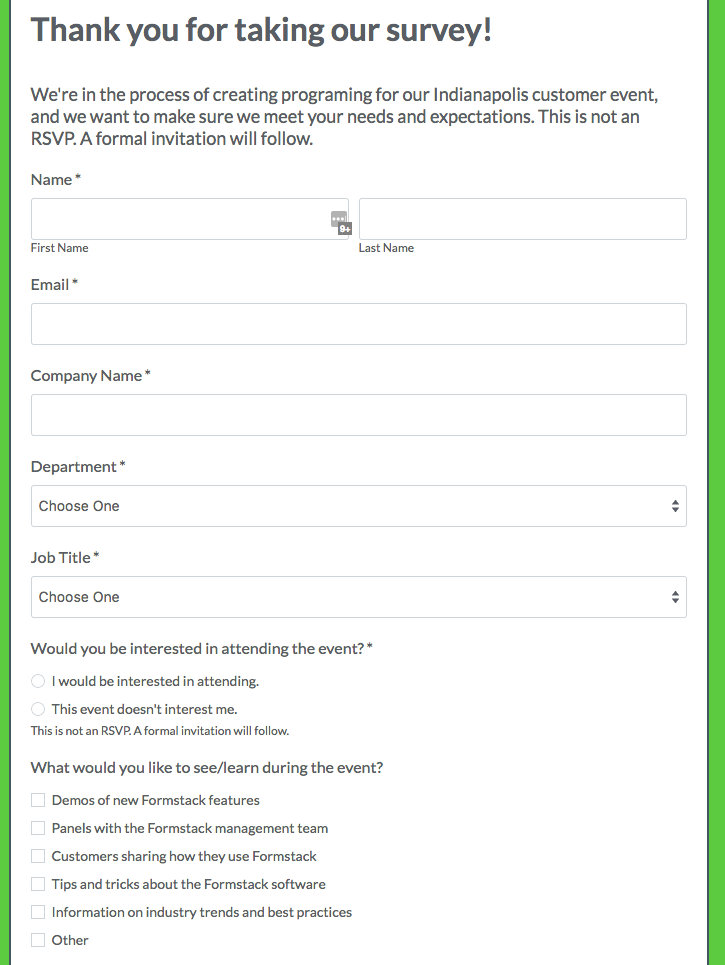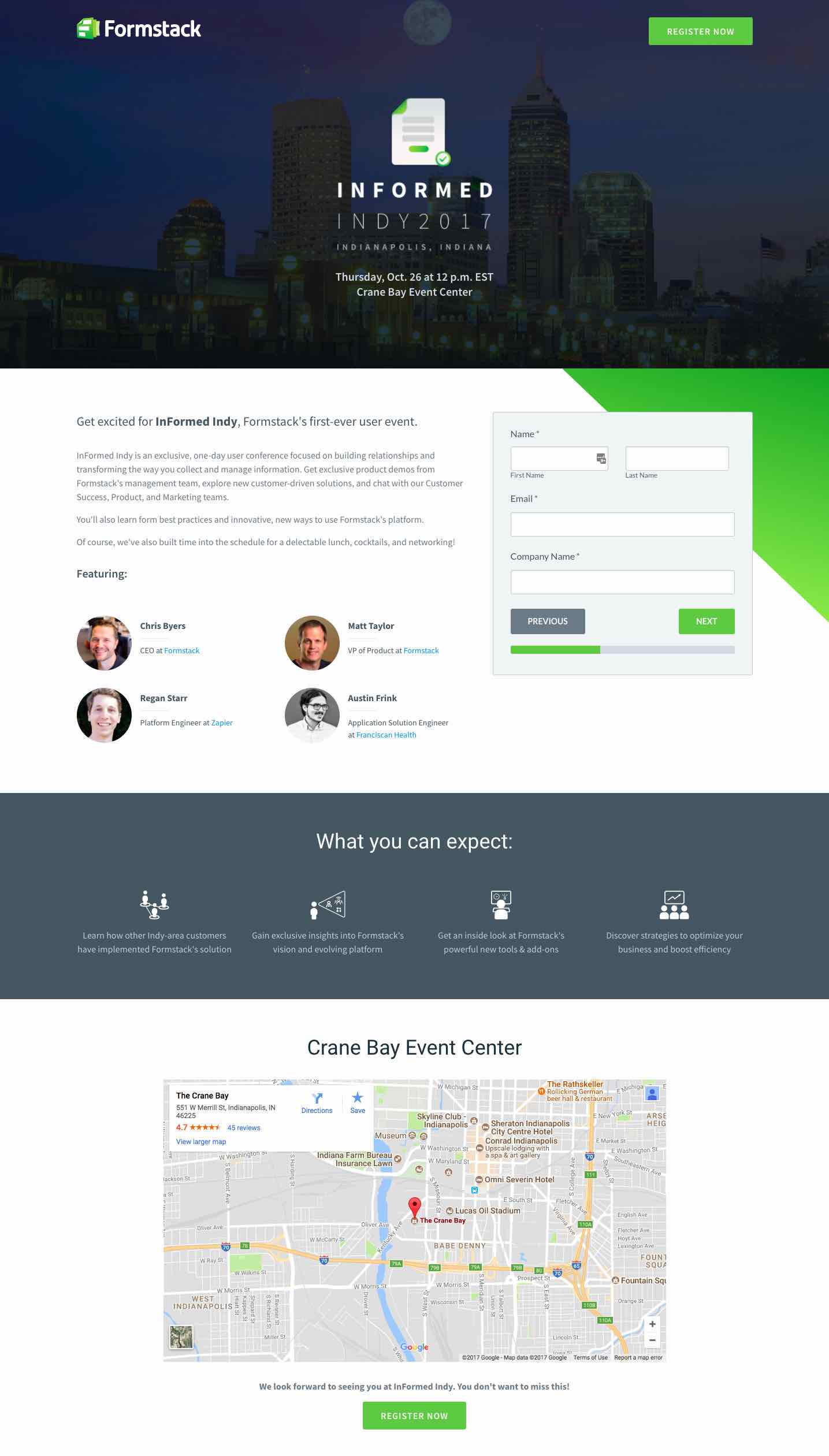If you’re a marketer in today’s digital world, you’re undoubtedly juggling a lot. And with an already-full plate, you might be pushing offline event planning to the wayside. But before you fully abandon the idea of hosting a branded event, consider what you’re throwing away:
According to a Cvent research report, events and tradeshows are a highly effective marketing tactic, second only to a company website. Additionally, 74% of event attendees say they have a more positive perception of a company after attending one of its events.
Clearly, it’s worth it to make time for in-person events. If you just want to test the waters, a good place to start is with a small, local user conference. Formstack recently went this route with our first-ever user event, InFormed Indy 2017. It was a free, half-day conference that brought around 100 Indianapolis-based Formstack customers together to learn more about our product offerings, use cases, and future plans.
In our opinion, InFormed Indy 2017 was a success. Now, we want to share how we pulled it off with just eight weeks of strategic event planning. To start, we formed a dedicated planning committee that met regularly to brainstorm, delegate, and prioritize. Here’s a breakdown of their event planning work to help you organize your own successful event:
#1: Determine Goals and High-Level Strategy
[8 Weeks Out]
The most important step in your event planning process is determining the why. What is the purpose of your event? Are you hoping to inform and engage existing customers, or do you want to capture the attention of potential new customers? You must answer these questions before you can really dive into your event planning. You’ll also want to determine the event’s scope and overall focus, as well as whether it will be a free or paid event. Finally, you’ll want to lay out specific goals—which can be anything from providing thought leadership on a certain topic to hosting 500 attendees to generating $10,000 in revenue.

Pro tip: Conduct an online survey of those in your target attendee group to gauge interest in the event and gather content ideas.

#2: Agree on Time and Place
[7 weeks out]
Once you have the ball rolling on your event, you need to secure a location and timeline. Start by comparing venues and their offerings, such as catering, audiovisual equipment, lighting, and signage. Then consider pricing and availability. Check venue availability against the availability of key stakeholders for your event (i.e., the planning committee and speakers). Then decide on event timing. Are you planning for a half-day event, a full-day event, or a multi-day event? You’ll need to know this information before booking the venue.

Pro tip: After you’ve nailed down a time and place for your event, send out a “Save the Date” email to let employees and customers know.
#3: Create a Basic Content Outline
[6 weeks out]
Before you ramp up promotion of your event, you’ll want to have a basic idea of the content schedule so you can plug key topics and speakers in your promotions. At this point, you should know the general timeline and have at least a few confirmed speakers. You should also have a good idea whether you will offer breakout sessions or stick to one main stage.

Pro tip: Keep it simple for your first event and present all content on one main stage.
#4: Collect Registrations
[5 weeks out]
Now it’s time for the fun! Once you’ve sorted out the main event details, you can start collecting sign-ups. The best way to do this is through a dedicated event landing page that includes an online registration form. The page should display the event date, time, and location, as well as a brief summary of what attendees can expect. To get traffic to this page (so people actually register!), you can promote it on various social media channels and in email communications.


Pro tip: To build recognition for your event, create a custom event logo that you can use throughout your promotions.
#5: Finalize Event Offerings
[3–4 weeks out]
As you get closer to the event date, you’ll want to finalize all event details. This means choosing food and drink menus and paying the caterer or venue, ordering and preparing event swag, confirming any exhibiting booths, and finalizing the event schedule (including any networking periods you will offer). This is also a good time to ensure you have people to staff your event so that all offerings are possible. Enlist your employees to help welcome guests, manage presentation slides, and man any necessary booths.

Pro tip: Give people extra reasons to show up—food, drinks, and event swag are all great incentives!
#6: Coordinate Day-of Logistics
[2 weeks out]
The day of an event can be hectic, to say the least. So it’s helpful to nail down day-of logistics a couple weeks ahead of time. You should have a group of people dedicated to event setup and teardown. These people will be responsible for getting all necessary equipment to and from the venue. You should also have a dedicated photographer who can capture high-quality photos of the event for future use. Additionally, you should create a social media hashtag ahead of time and make sure you have a plan for creating social chatter during the event (such as through a contest).

Pro tip: Create a detailed checklist of items to bring to the venue on the day of the event so nothing gets left behind.
Final Thoughts
That’s all there is to it! The day of the event, you simply put your plans into motion and stay agile. After the event, you should reflect on how it went and discuss how offline events may play into your future marketing efforts.
Event planning can be hard, but it doesn’t have to take months and months of work. If you stay organized and keep it simple, you can plan an outstanding event in just eight weeks!
Want more event planning tips? Click here to check out our “The Anatomy of a Perfect Event” infographic.











